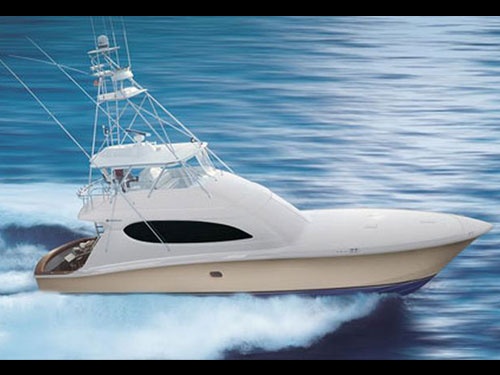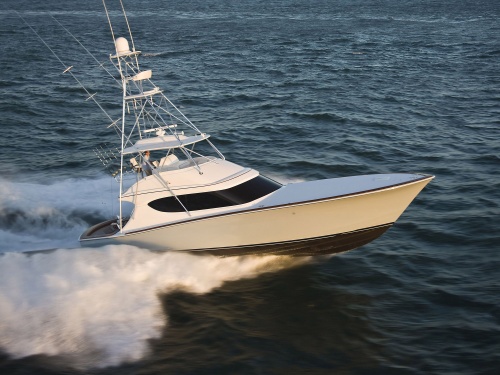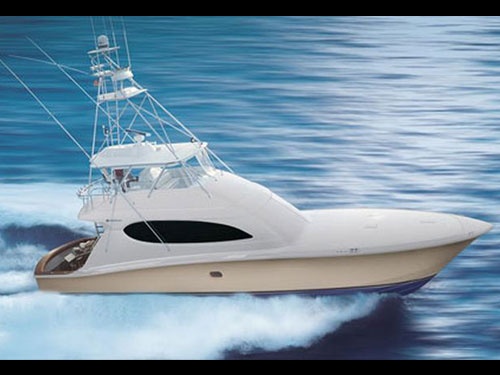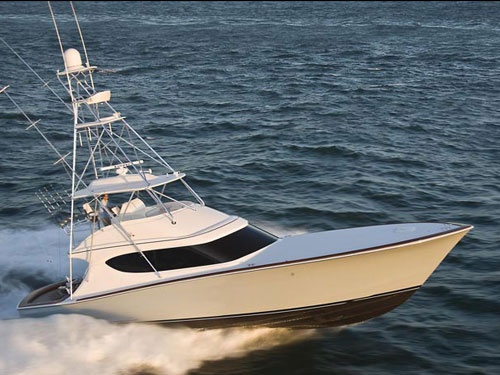Access More Boat Tests
Already have an account? Login
Hatteras GT59 (2019-)
2 x 1,900-hp CAT C-32A
Price
See the price by becoming
a BoatTEST member.
Members Must Log In
Brief Summary
Hatteras built the GT59 to fill a perceived hole in their GT sportfish lineup between the 54’ and 63’ (16.45 m and 19.20 m) models. It is not a stretch of the earlier model but its own unique design from the keel up. The GT59 is built for the serious billfish tournament angler with 40+ knot speed and style for extended trips offshore. But, remember she is a “convertible” and that means she can also be a cruiser. Because of her sea-keeping abilities and low CG, she should be a good one.
Key Features
- 40+ knot top speed
- 3 en suite staterooms
- Comfortable flybridge seating
- Widest beam in class, most shallow draft
- Painted hull, deck and superstructure
Test Results
| RPM | MPH | Knots | GPH | MPG | NMPG | STAT. MILE | NM | dBa |
|---|---|---|---|---|---|---|---|---|
| 600 | 9.2 | 8 | 8 | 1.2 | 1 | 1811 | 1575 | 79 |
| 1000 | 13.2 | 11.4 | 33 | 0.4 | 0.3 | 628 | 545.8 | 79 |
| 1250 | 17.9 | 15.6 | 57 | 0.3 | 0.3 | 495 | 430.1 | 83 |
| 1500 | 25.7 | 22.3 | 83.5 | 0.3 | 0.3 | 485 | 421.5 | 85 |
| 1750 | 32.6 | 28.3 | 118.5 | 0.3 | 0.2 | 433 | 376.2 | 89 |
| 2000 | 39 | 33.9 | 164 | 0.2 | 0.2 | 374 | 325.3 | 90 |
| 2200 | 43.6 | 37.9 | 192.5 | 0.2 | 0.2 | 357 | 310.2 | 91 |
| 2250 | 46 | 40 | 207.5 | 0.2 | 0.2 | 349 | 303.6 | 91 |
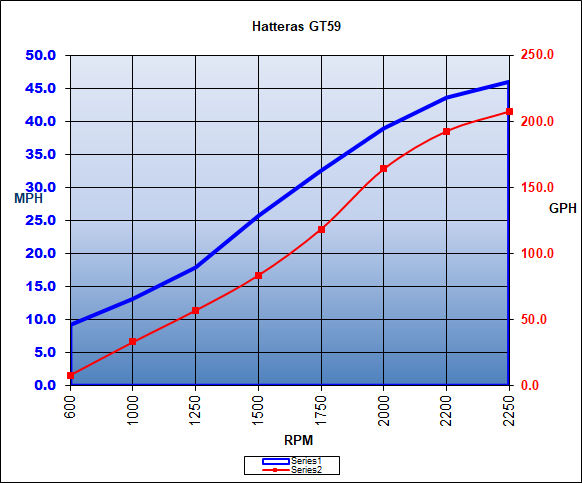
Specifications
| Length Overall |
59'9" 18.21 m |
|---|---|
| Beam |
18' 9'' 5.72 m |
| Dry Weight |
89,000 lbs. 40,370 kg |
| Tested Weight |
101,890 lbs. 46,217 kg |
| Draft |
4' 9'' 1.45 m |
| Fuel Capacity |
1,750 gal. 6,624 L |
| Water Capacity |
200 gal. 757 L |
| Total Weight |
101,890 lbs. 46,217 kg |
Acceleration Times & Conditions
| Time to Plane | 8.5 sec. |
|---|---|
| 0 to 30 | 12.6 sec. (0 to 20) |
| Load | 4 persons, full fuel, full water, 50 lbs. of gear |
| Climate | 72 deg., 58 humid; wind: 0-5 mph; seas: <1 |
Engine Options
| Tested Engine |
2 x 1,900-hp CAT C-32A |
|---|---|
| Std. Power |
2 x 1,600-hp Caterpillar C-32A diesel |
Contents of Report
- Mission
- The Convertible Concept
- Distinguishing Features
- Design
- Construction
- Comparison to the Competition
- Performance
- Handling
- Docking
- Boat Inspection
- Flybridge
- Helm
- Cockpit
- Side Decks and Bow
- Ground Tackle
- Cabin
- Galley
- Accommodations
- Master Stateroom
- Guest Stateroom
- Day Head/Shared Head
- Laundry
- Forward Stateroom
- Crew Cabin
- Engine Room
- Options to Consider
- Price
- Observations
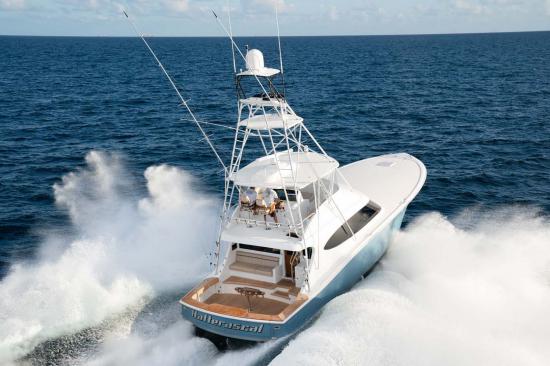
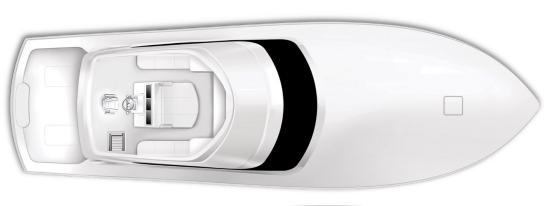

Mission
The Hatteras GT59 is designed for offshore big game fishing. This boat provides speed, comfort and storage for the avid tournament fisherman. The boat also suits different fishing styles so it will have a broad appeal from region to region. Further, with the greatest fuel capacity in class she is best able to cruise to distant locations for fishing. When not fishing, she provides excellent accommodations for cruising.
The Convertible Concept
There are stripped out sportfishing boats made for a single mission in life – hardcore offshore big game fishing – and there are “convertibles” made for the same thing, but with accommodations and creature comforts that make the boat a good cruising boat as well, with little if any compromise to its fishing attributes.
The advantages of a convertible are that it can make an excellent cruising boat, which gives the vessel utility that stripped-out sportsfishermen don’t have. Convertibles are built to take almost any sea condition less than a named storm. The GT59’s clean bow, elimination of a main cabin windshield and rugged construction allows her to take green water over the bow with aplomb.
With the three en suite layout, the GT59 can handle three couples or grandparents, kids and grandkids in complete privacy. Top side, there is plenty of seating for watching the yacht races, exploring, and just enjoying the day by a large group.
Cockpit Seating. The cockpit is also an ideal place for a cocktail party when at anchor, or on a slow evening cruise with friends. While our test boat didn’t have them, foldout seating can be installed in the port and starboard gunwales for anyone seriously wanting to use the boat for entertaining. Those seats, plus the mezzanine seating, can handle a number of people. The stanchion base for the rocket launcher or fighting chair can also hold a removable table for drinks and finger food.
The low CG inherent in any convertible, plus the GT59’s displacement, beam and sharp forefoot, make her as comfortable as it gets in this size boat for landlubbers – generally much more so than a conventional flushdeck motoryacht. The addition of the Seakeeper 16 on our test boat makes this boat even more comfortable.
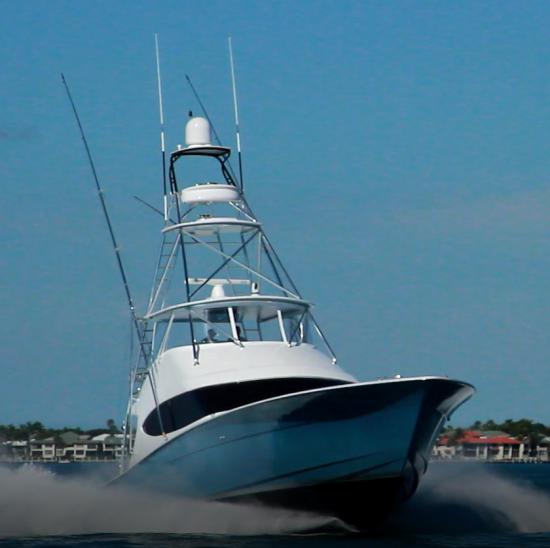
Distinguishing Features
- Tunnel drive hull
- Twin Cat C32 Turbo diesels 1,900-hp each
- 3 en suite stateroom layout
- Painted hull, deck, and superstructure
- Solid fiberglass bottom
- Salon/galley layout
- Her 18’9” (5.72 m) beam
- Her 4’9” (1.45 m) draft
Design
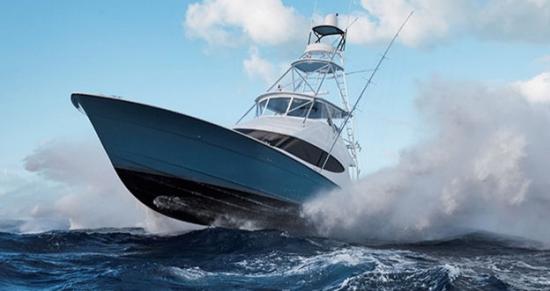
A variable degree deadrise in the bottom, lifting strakes, and hull tunnels aft all contribute to the GT59’s performance. It is also a proven design over the years by Carolina charter skippers who need to get their clients offshore fast but in comfort.
The hull tunnels over the props, and her considerable beam, allow her to draw less water than the competition, which means that when docked in front of the house in a shallow area, it’s slightly less vulnerable to moon tides.
Her bow has the famous Carolina Flare that keeps the boat dry and provides buoyancy in nasty conditions offshore. Otherwise, she has a traditional convertible styling with a sweeping sheer line.
Construction
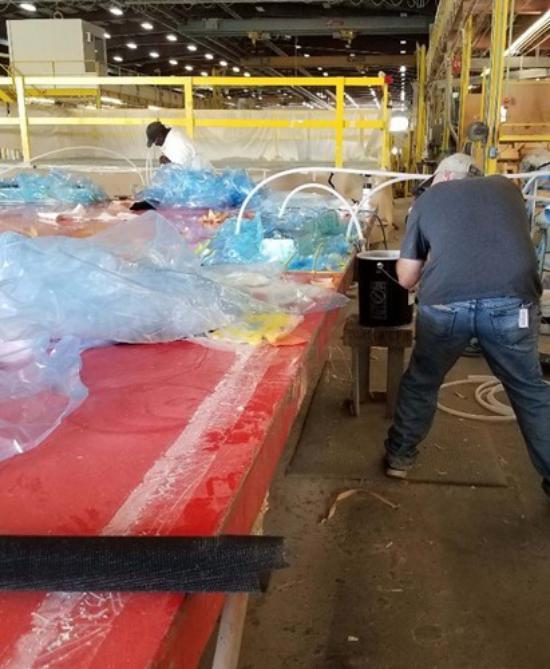
On most boats, the hull is laid up first, then the stringers are tabbed in after for strength. On the GT59, the stringers were added in the original infusion, cutting out a production step, but designed to make the boat a stronger single piece. It also ensures that a 60-40, glass-to-resin, composite is created, which is lighter and stronger than a hand laid laminate.
Solid Fiberglass Bottom. Perhaps the most important distinction between the Hatteras GT59 and her competition when it comes to construction is that her bottom is solid fiberglass. Hatteras has long believed that this is the key to the boats’ integrity in adverse conditions, such as hitting a partially submerged cargo container or rock.
Most of the competition have cored hulls to make them lighter. The trouble is, all cored hulls are more vulnerable to punctures. Nothing is more puncture resistant than a solid fiberglass hull, other than steel.
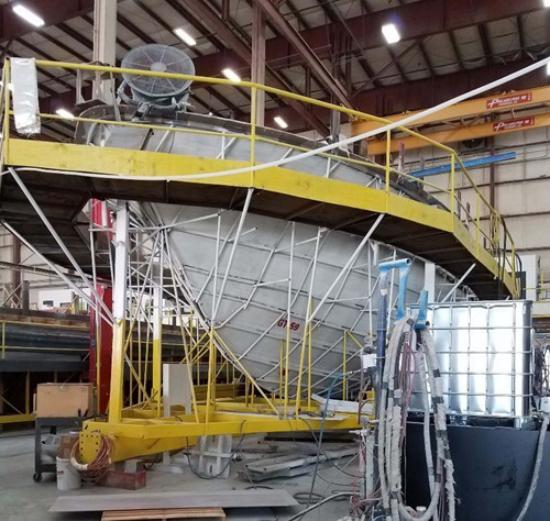
Painted. Hatteras paints the hull, deck and superstructure which has lots of advantages over gel coat, which is what most boats have, including this boat’s competition. Gel coat oxidizes at a relatively rapid rate and the tropical sum is particularly hard on it. This necessitates constant compounding and waxing in order to keep up its like-new gloss.
A painted hull, on the other hand, requires no more maintenance than washing down with soap and water, and should stay looking like new for 10 years or more. Repairs are also far easier to make with a painted hull and usually cannot be seen. What’s more, a painted hull in navy blue, or battleship gray makes for a stunning boat that sets it apart from the Clorox bottle white of most boats. Like a lot of things Hatteras does, painting the hull, over the gel coat, is more costly.
Consumer Caveat. Carbon particulates in the air from smoke stacks or rubber from nearby highways needs to be washed off with soap and water on both painted and gel coat at regular intervals, otherwise with time it gets embedded in the surface of both materials.
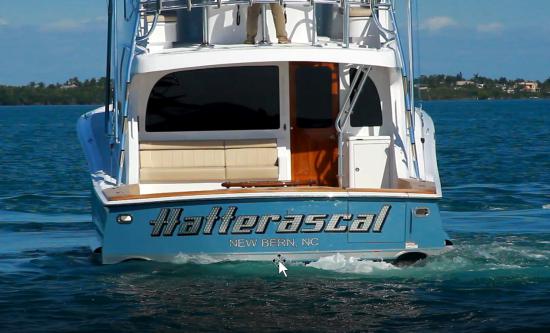
Comparison to the Competition
There aren’t many convertibles built these days in a league with the Hatteras GT59, but when we compare the boat to the few that are, we see some important differences. Here are the major ones—
- Beam: At 18’9” (5.72 m), the Hatteras GT59 is a full foot beamier than its competition. This makes the boat larger all over, and more stable.
- Fuel Capacity: At 1,750 gallons (6,624 L), the GT59 carries about 200 gallons (757 L) more fuel than her competition. That means more time to troll and greater range when cruising or delivering the boat for destination fishing.
- Draft: The Hatteras draws just 4’9” (1.45 m) due to her greater beam and her tunnels. This is less than her competition, an important consideration when traveling in the Bahamas or docking in front of the manse.
- Displacement: The GT59 is about 7,000 lbs. (3,175 kg) heavier than her prime competition, largely due to her solid fiberglass bottom. Hatteras has chosen hull integrity over top end speed when it comes to this crucial building decision.
- Engines: The Hatteras comes standard with twin CAT C-32A 12-cylinder engines developing 1900-hp each. This is a total of 400-hp more than the competition’s standard engines. Higher horsepower engines are available for all brands. An important advantage of CAT engines is their large number of service facilities throughout the U.S. and worldwide. CAT engines are probably the most popular engines in commercial fishing boats in the U.S. in their horsepower range. Their engines can be heavier than some other engine brands, which is the trade-off for better service and quicker parts availability.
- Painted Hull, Deck, and Superstructure. As mentioned above, all Hatteras yachts are painted, which has numerous advantages, unlike other boats in class.
- Solid Glass Bottom. In class, only the Hatteras GT59 has a solid glass bottom below the waterline. By eschewing a cored bottom, Hatteras has opted for a far more puncture-resistant bottom. Cored hulls have two relatively thin laminates separated by either PVC foam or end-grain balsa core.
- 3 En Suite Staterooms: Only Hatteras offers three staterooms all with their own head with separate walk-in showers. This is a welcome layout when cruising with a family, much less with strangers. The starboard head also serves as the day head.

Performance
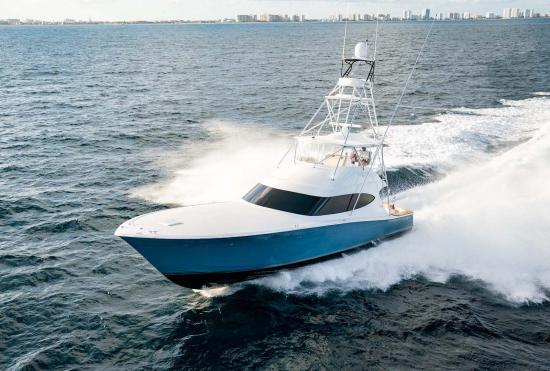
The GT59 has an LOA of 59’9” (18.21 m), a beam of 18’9” (5.72 m), and a draft of 4’9” (1.45 m). With an empty weight of 89,000 lbs. (40,370 kg), full fuel (1,750 gallons / 6,624 L) and water (200 gallons / 757 L), plus four people onboard, we had an estimated test weight of 101,890 lbs. (46,217 kg).
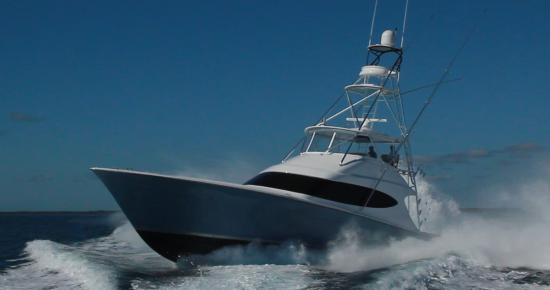
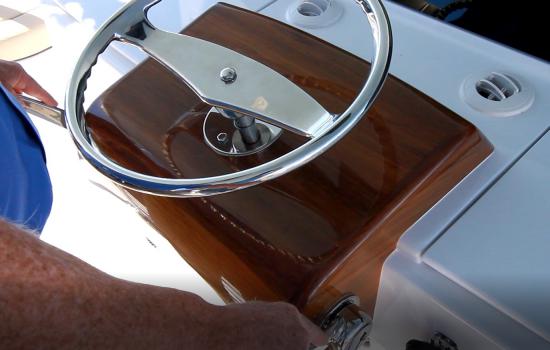
The Numbers. With twin Caterpillar C-32A 1900-hp diesel engines powering our test boat, we reached a top speed of 40 knots at 2250 rpms in calm conditions.
When we backed off to 2000 rpm and 33.9 knots, we found our best fuel economy, with a burn rate of 164 gph and a range of 325.3 nm, all while still holding back a 10-percent reserve of the boat’s 1,750-gallon (6,624 L) total fuel capacity.
Acceleration. The GT59 came up on plane in an average of 8.5 seconds and got to 20 mph in 12.6 seconds.
Handling
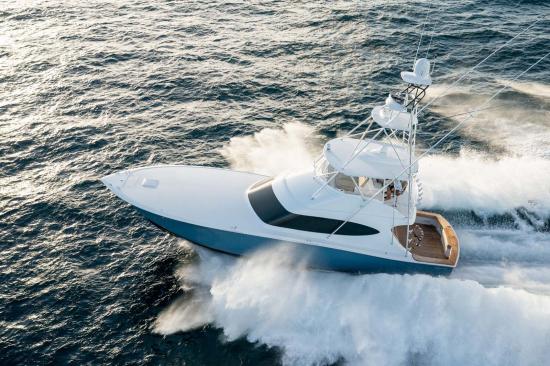
The GT59 has a wide turning radius. At a 2000 rpm cruise, which is about 80% load, she has about six boat lengths turning radius and turns 180-degrees in 34 seconds.
This turning radius suggests that the rudders are not particularly large – in order to reduce drag. This is a fair trade-off for this kind of boat that is made for distance running, straight, long and far. Around the dock, of course, the rudders are not used, only the props and thruster. When backing down on a fish, again the gears and the thruster do the work.
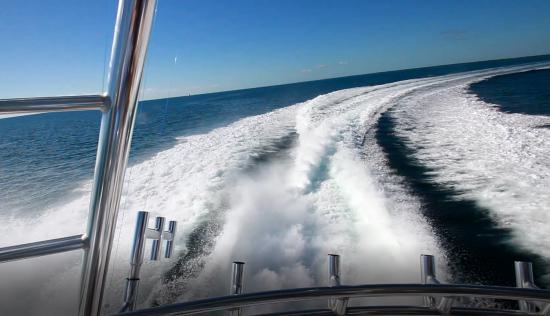
We had calm conditions for our test which is unfortunate because this is an offshore boat and we can’t really describe how she handles in offshore conditions, but it is a solid boat, so we are unconcerned. She’s robust, and with her sharp forefoot and considerable displacement, she should be as comfortable as any boat in class, if not more so.
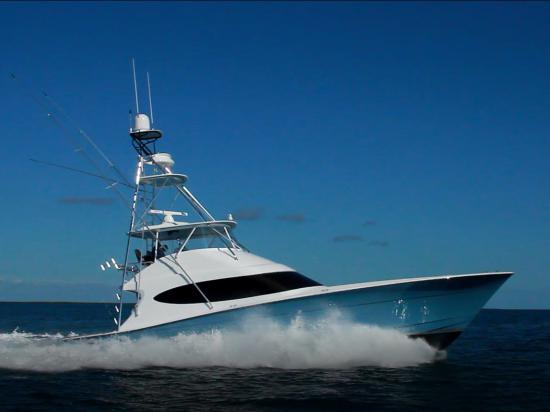
Docking
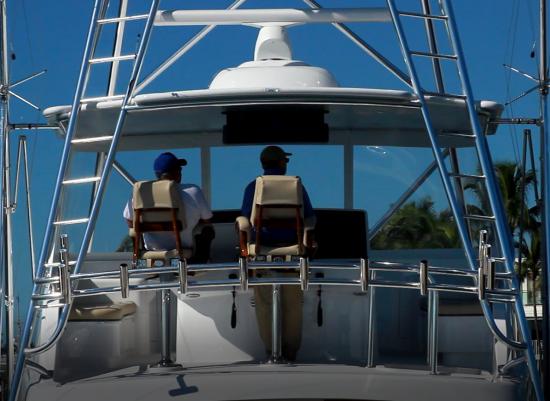
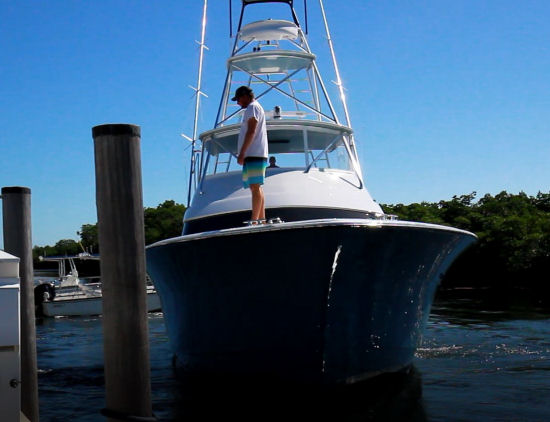
After we threaded our way back up the inlet, docking with the bow thruster and gears was easy. Remember, generations of convertible owners and captains did this for years without a thruster.
Boat Inspection
Flybridge
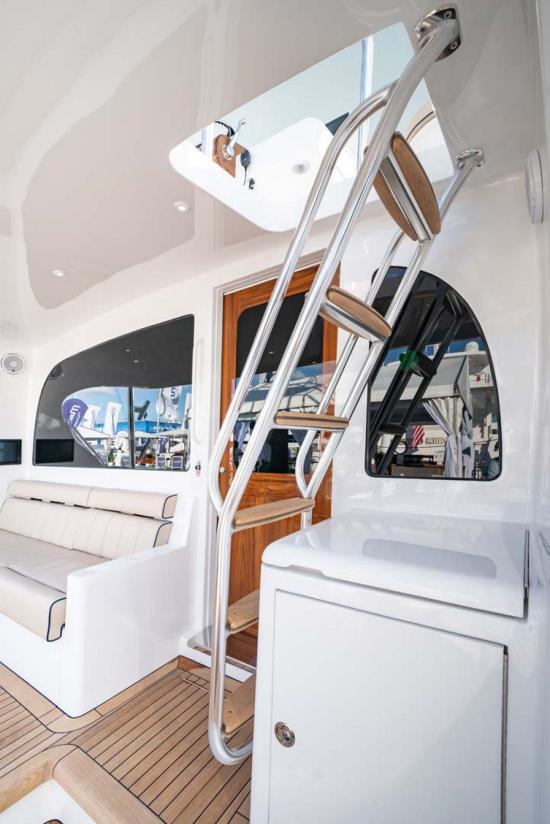
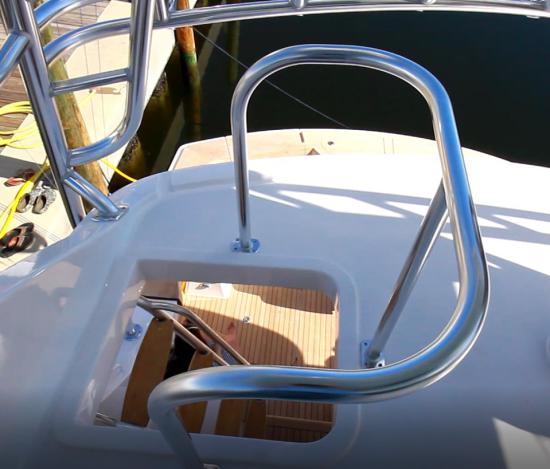
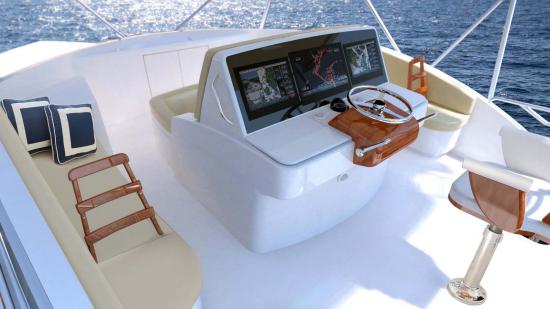
Helm
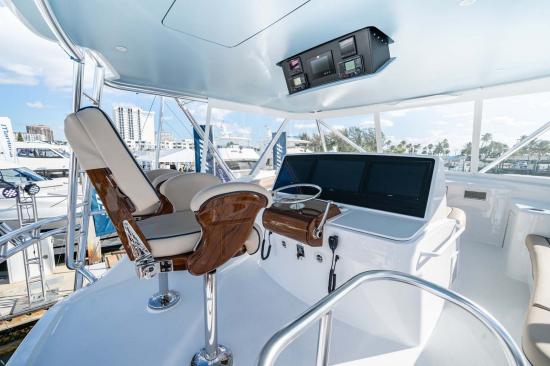
When standing behind the helm, we can barely see the compass which is mounted way up forward. We’d prefer to see it mounted on the console.
On either side of the wheel are hinged cubbies with gas shocks that open to reveal instruments and controls typically needed for docking or maneuvering. These can be left closed most of the time while underway. Keeping with the clean look, the stainless steel wheel is mounted bus-style on a Palm Beach base of high-gloss finished walnut, flanked by the engine throttle and shift sticks.
On the instrument panel, we have two 17” (43.2 cm) displays flanking a 22” (55.9 cm) display. When needed, simply open the panels on either side of the wheel to find, on the left side, a spotlight control, trim tabs, bow thruster, engine controls, electric steering, and the SeaKeeper gyro stabilizer control.
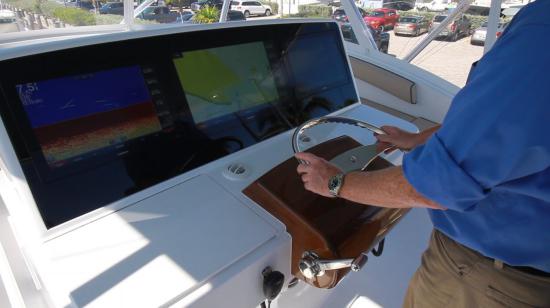
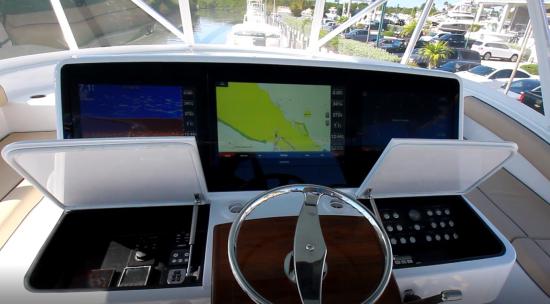
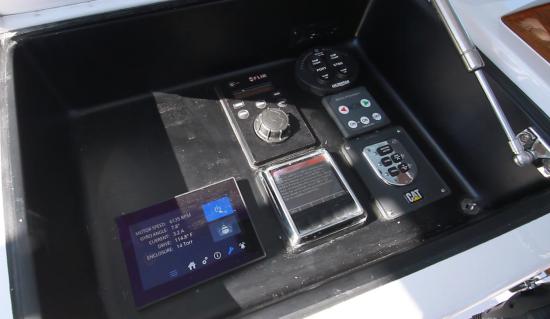
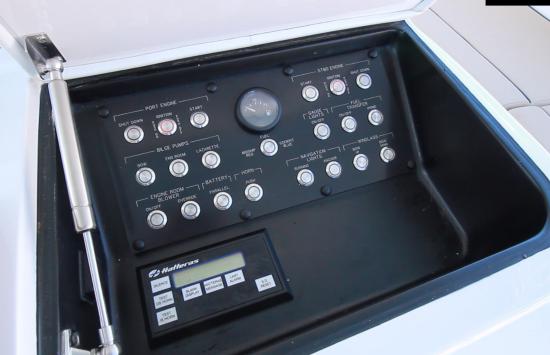
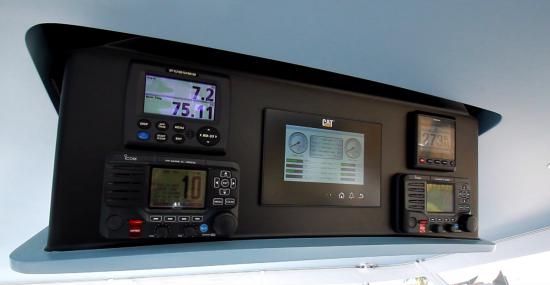
Overhead Electronics Box. It looks cool to have an overhead electronics box, but there is a downside to them – they can become a pain in the neck. Sometimes it is also hard to read the information provided, or needed. We prefer to put things there that are not often used. For example, most of the controls in the port compartment will be referred to less often than almost everything in the electronics box. We would rearrange the controls. And there is more space left in the starboard compartment as well.
Obviously, placement of these secondary controls and navigation devices are up to the owner.
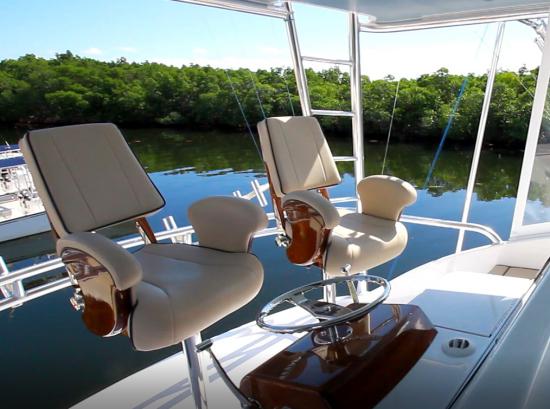
The helm seats are mounted on high pedestals and they swivel. Hatteras long ago broke the code on how to make them solid. The leather-covered ladder-back chairs are trimmed in the same walnut accent found on the Palm Beach helm.
The isinglass enclosure on the flybridge is a good option to have because it keeps things cozy when the day is cool and protects from the rain. However, when driving in rain or in dense fog, it is problematic because there are no windshield wipers. The addition of glass windshield panels with electric wipers that lower from the overhead could be one solution for people wanting to use the boat for extensive cruising.
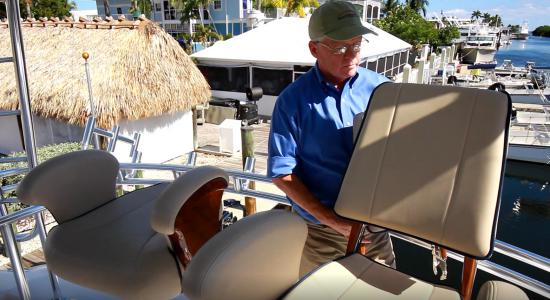
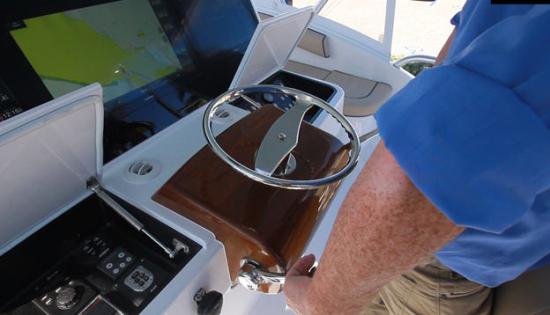
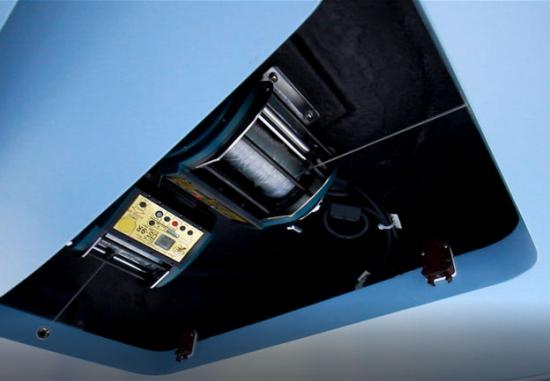
The hideaway theme continues in the flybridge overhead where a panel opens to reveal two fixed electric teaser reels. Close the panel and equipment is instantly stowed.

Behind the helm chairs is a short platform for viewing the cockpit action below and moving around. It is surrounded by a double piped rail with eight built-in rocket-launcher rod holders.
On our test boat, there was a three-quarter enclosure of isinglass which nominally allows the flybridge to have A/C.
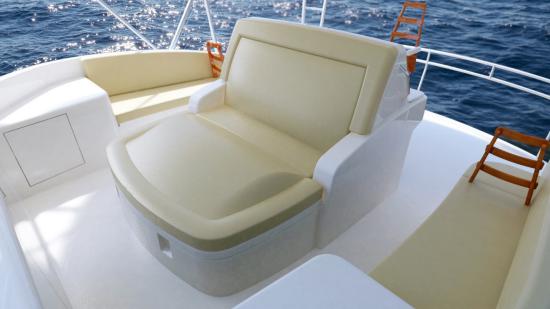
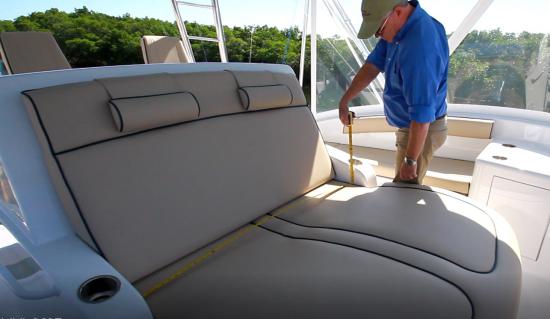

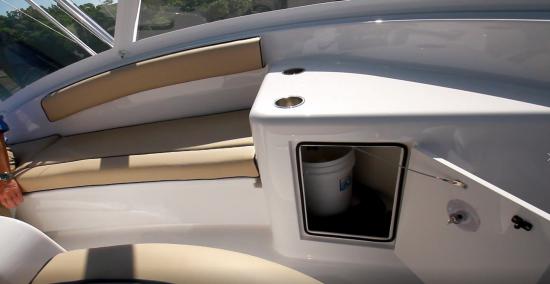
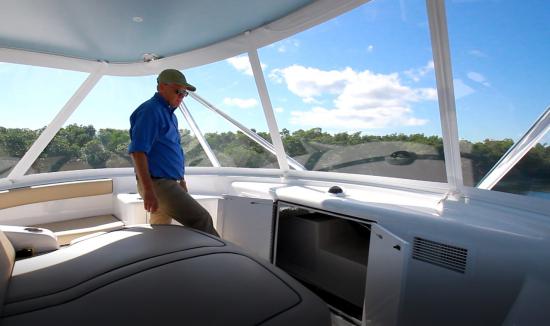
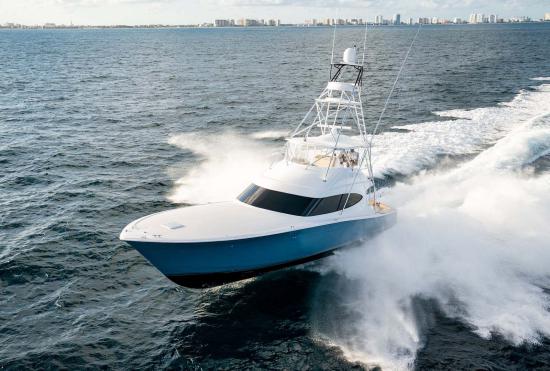
Above the flybridge helm is a tuna tower with an auxiliary helm. There is a hardtop overhead for UV protection and to provide a place to mount other gear.
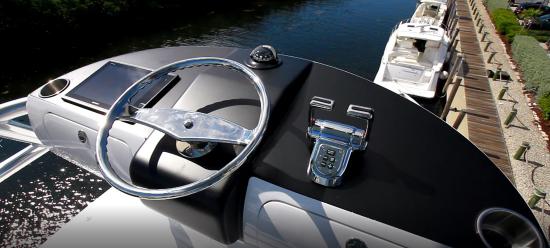
The tower helm is simple and clean looking with a 12” wheel, the engine controls on the right, and a Garmin screen to the left of the wheel with a stainless steel cup holder on either side. Flanking the wheel are glove-box style bins. The tower helm has a padded bolster surround.
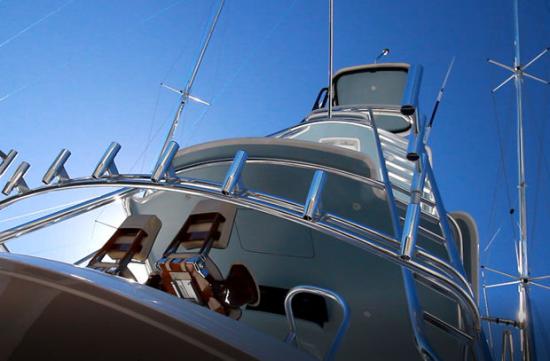
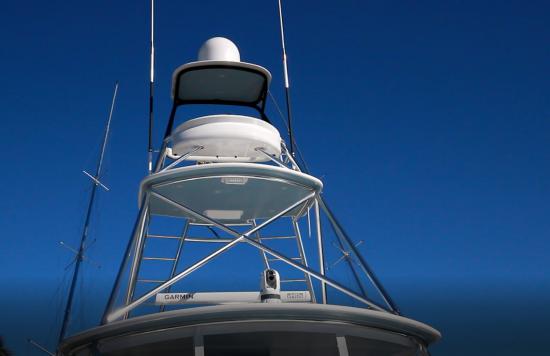
Cockpit
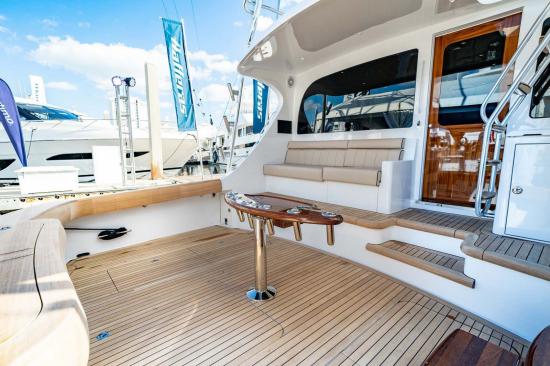
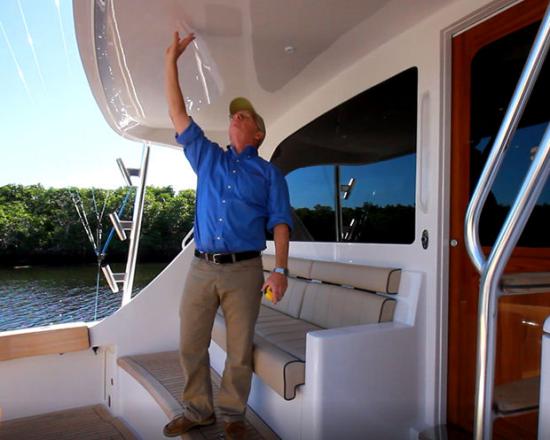
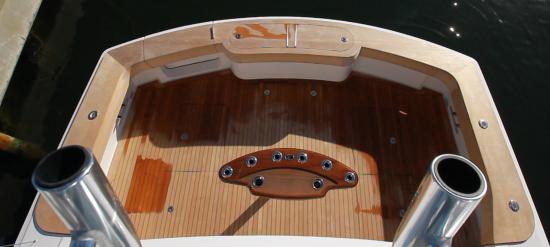
The GT59 has a 8’x14’w cockpit with teak decking, mezzanine seating and our test boat had an optional high gloss-finished mahogany leaning post with six rod holders. A plate is glassed in under the deck to take a fighting chair.
The cockpit depth is 29” (73 cm) and the covering boards on the sides are 13” (33 cm) wide.
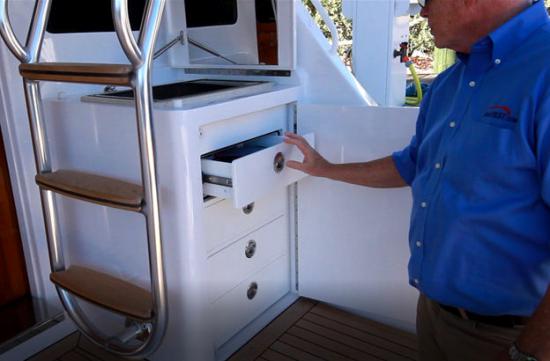
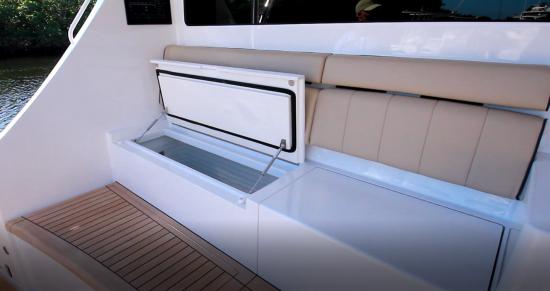
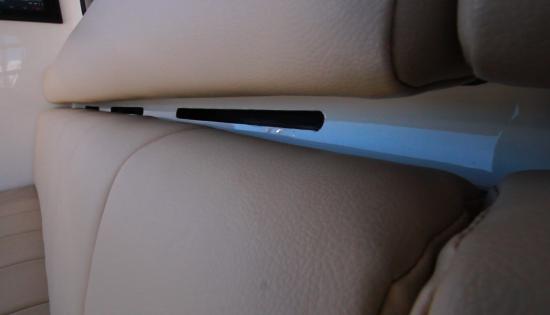
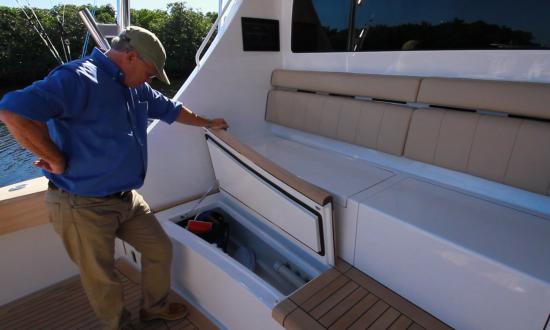
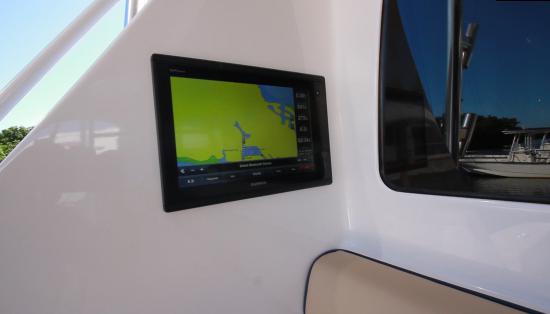
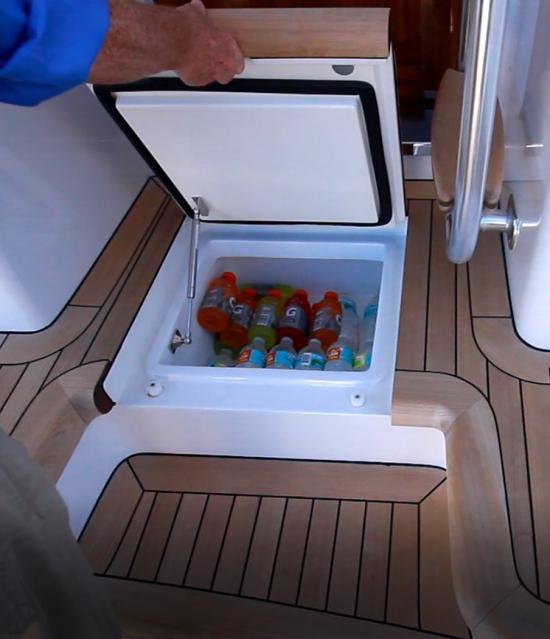
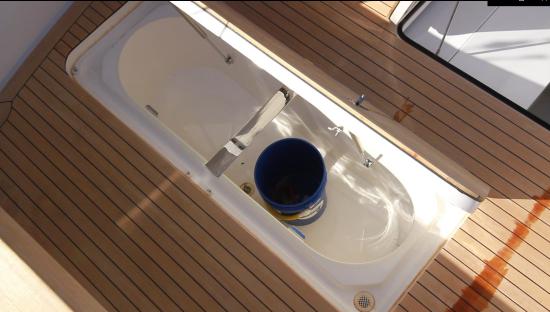
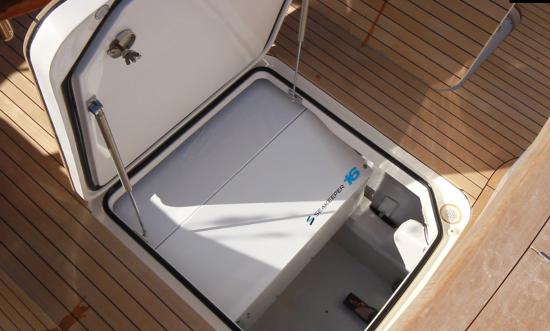
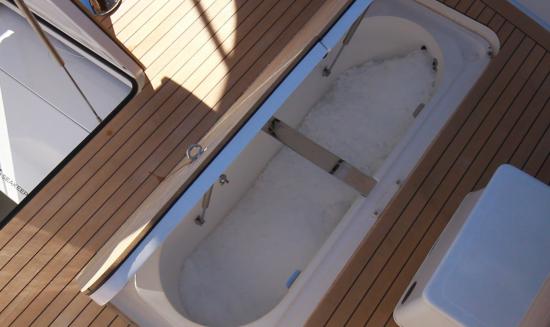


The shore power cord locker on the port side also has a freshwater washdown. The 13” (33 cm) wide teak caprail contains two rod holders on each side and a large fishbox with twin opening hatches in the transom.
Below the 29” (73 cm) high gunwale are 15” (38 cm) mooring cleats with hawseholes through the transom. Also, there is a transom door with sturdy hardware and a proper covering board.
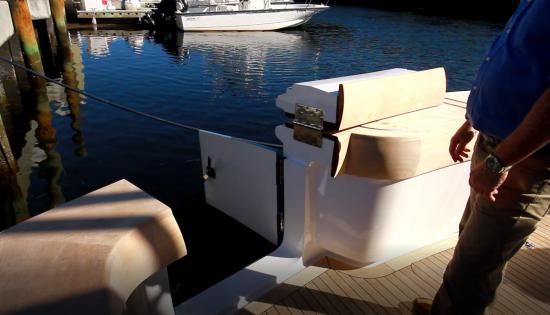
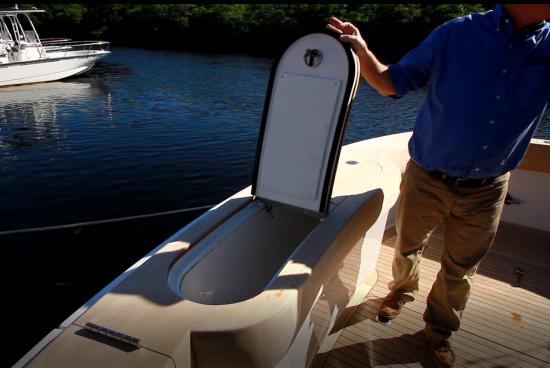

Side Decks and Bow
Ground Tackle
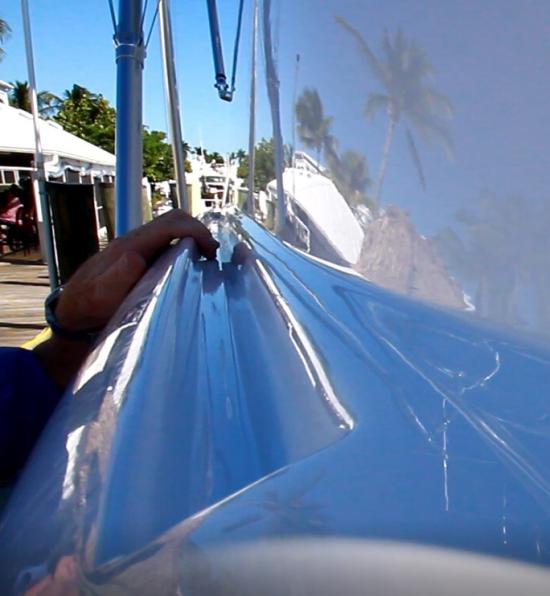
In order to check out the anchor and ground tackle, we make our way forward up the side deck. There is no rail on the side decks nor on the bow, but this is typical for this kind of boat.
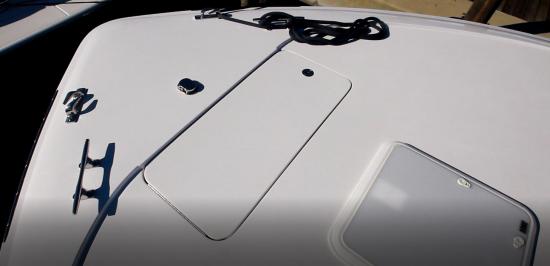
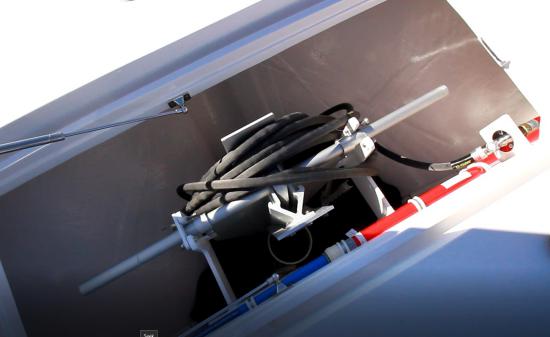
There is no anchor windlass. In the rare event of needing to anchor in an emergency, manhandling the anchor will have to do. That’s what hired captains and mates are paid to do.
There are 15” (33 cm) cleats on either side of the bow to secure the rode. These lead to stainless steel chocks and a stainless strip on the toe rail to prevent chafe. There is another set of cleats on the toe rail further aft for tying up with spring lines.
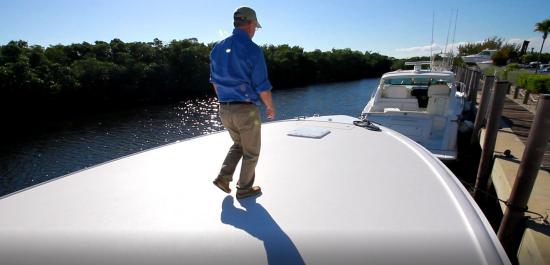
Cabin

The wood door has a window in the top half. Once opened, the door is locked in its pocket out of the way – no swinging doors slamming on the roll here.
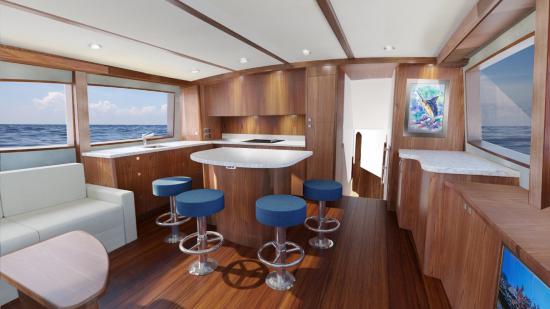
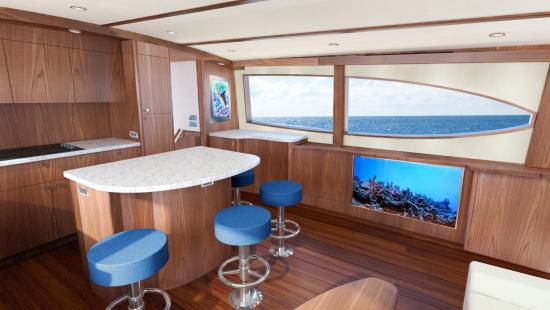
The cabin is surrounded on three sides by windows letting in plenty of light to reflect off the gloss-finished mahogany wood trim of the interior. The L-shaped settee has a fixed teak coffee table with storage inside. Optionally, a dinette table is available to replace the coffee table. The settee has 4” (10.16 cm) faux leather cushions. Manufactured hardwood wide-planked flooring covers the deck.
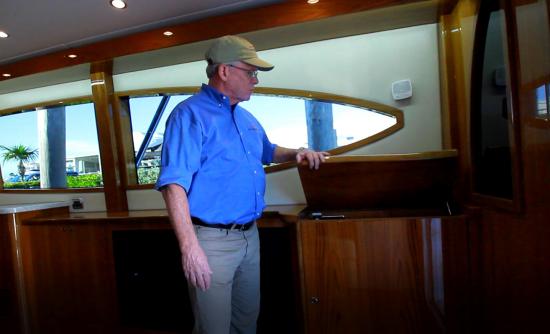
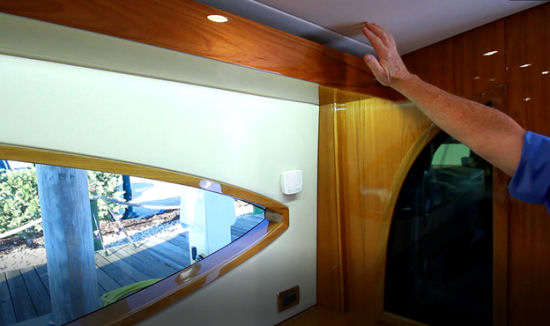
Galley
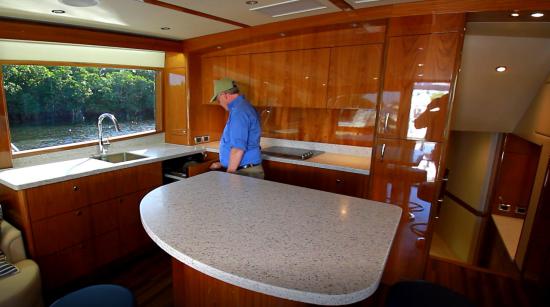
A center island with four barstools separates the seating area from the galley. This hard surface counter was also for breakfast and lunch on our test boat – remember, her primary mission is to get to the fishing grounds early and be home for dinner. We find this arrangement far more comfortable than layouts with a raised table in front of a crescent settee to starboard – which really isn’t practical for portly anglers.
The L-shaped galley has cabinetry and a sink on the port side. The Silestone countertop continues around the forward side with more cabinetry and an induction cooktop, ending in a floor-to-ceiling pantry.
The island galley is far more practical than the traditional “alley galley” with only one way in and out. These are pretty much limited to one person at a time whereas with an island galley there are two ways in and out, and two or three people can use it at a time.
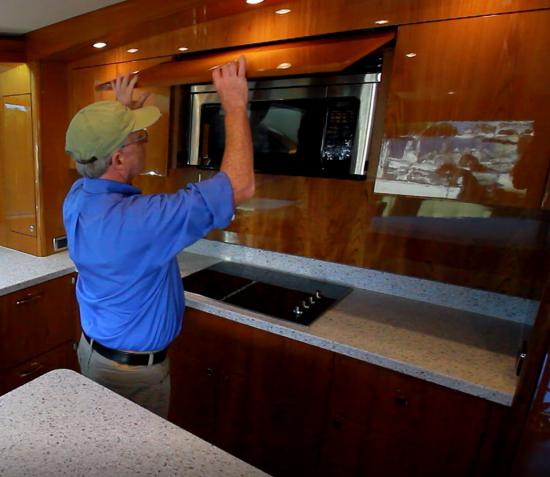
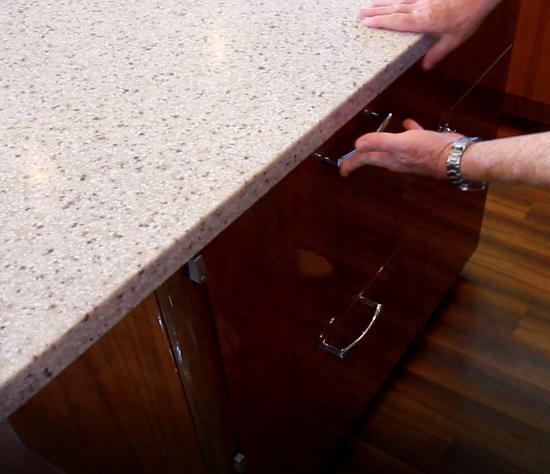
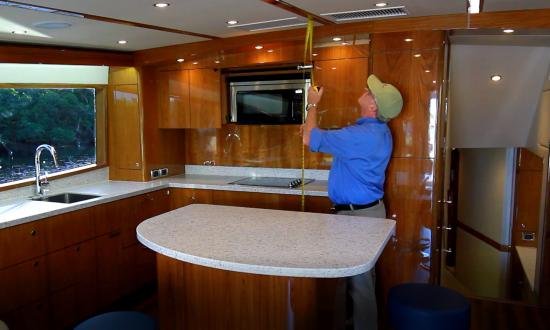
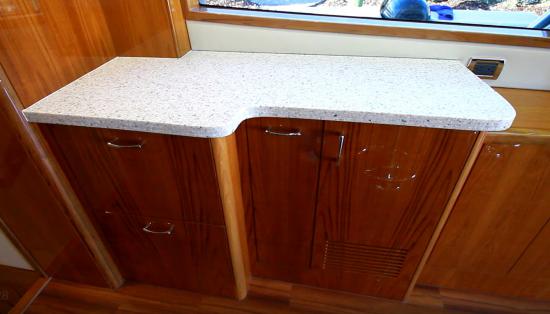
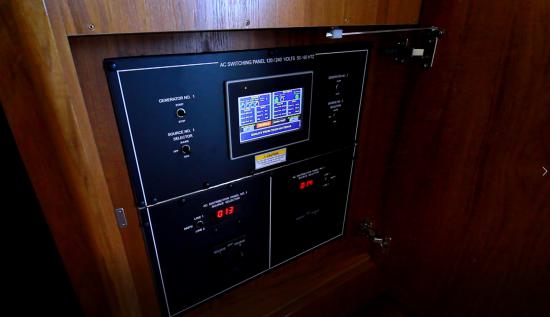
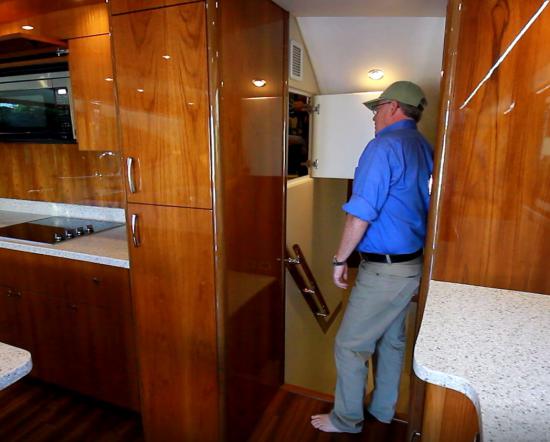
Accommodations

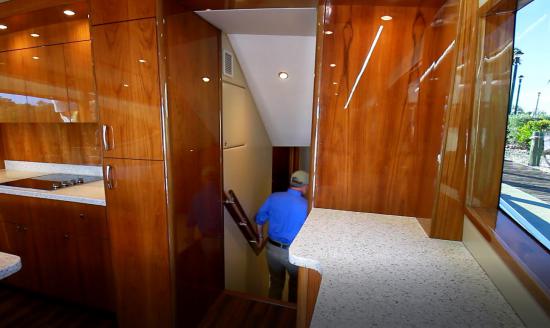
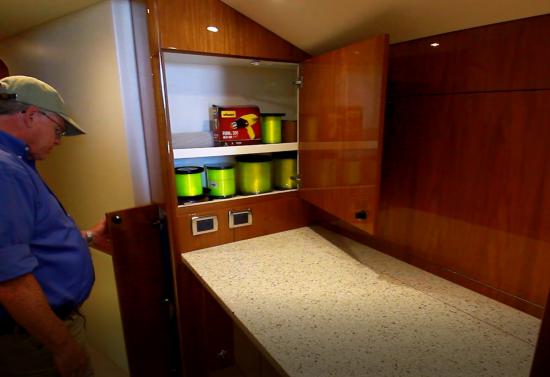

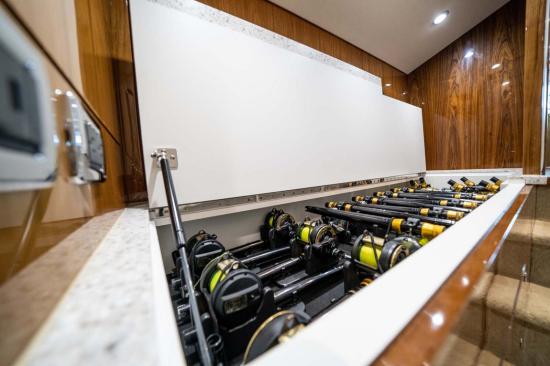
The passageway and all of the staterooms are carpeted.
Master Stateroom
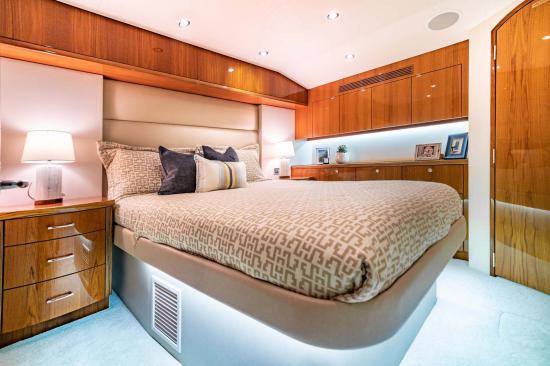
The master, just down the stairs, is to the left. It has 6’5” (1.95 m) headroom, a large island berth with 4’2” (1.27 m) over the bunk, and a private en suite. The round top doors and high-gloss joinery work speaks to the craftsmanship inherent in the GT59. There is a padded headboard over the berth. On the far side is a six-drawer bureau with four cabinets overhead.
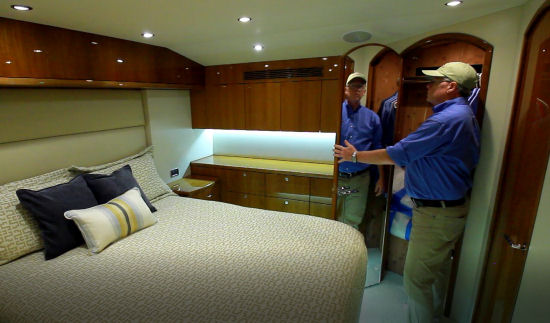
Master Ensuite
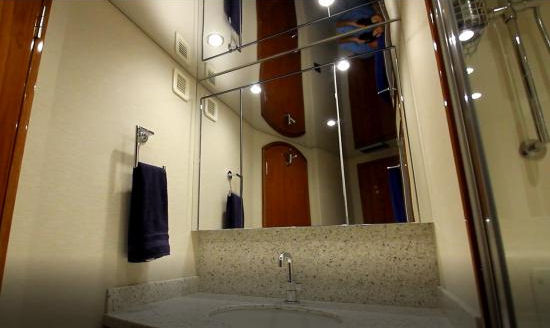
The master head has a walk-in shower stall with a glass door and a single sink Silestone-topped vanity.
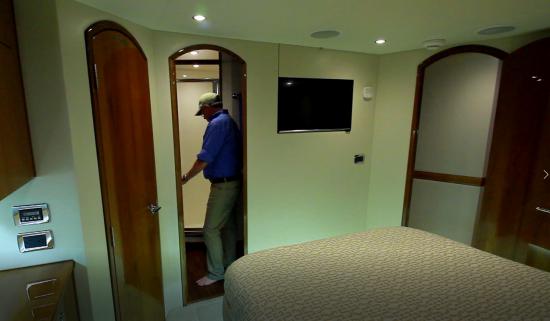
Leaving the master, we pass a 32” (.81 m) flat screen on the bulkhead opposite the foot of the bed.
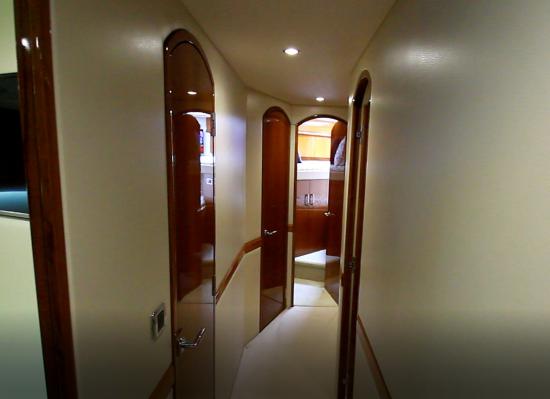
We continue our tour of the accommodation space by going forward in the passageway. There is a cedar-lined closet on the left currently being used for more rod storage, and just past this on our right is a cabin with two bunk beds.
Guest Stateroom
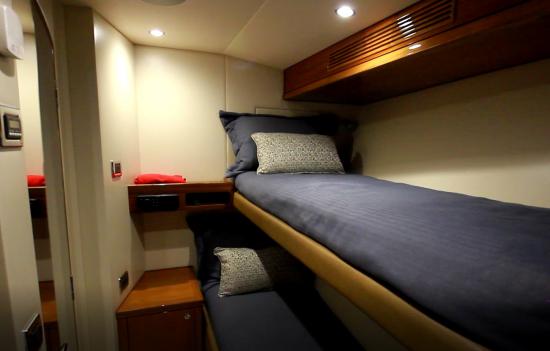
At the head of the bunks is a nightstand for the lower bunk and a shelf with a Fusion stereo system for the upper berth. There is a full-length mirror on the back of the door and another cedar-lined hanging locker at the foot of the bunks. Opposite the hanging locker is a wall-mounted 24” (60.9 cm) flatscreen. This cabin has a padded leatherette wall covering.
Day Head/Shared Head
Continuing forward in the passageway from the starboard cabin is access to the shared head/day head.
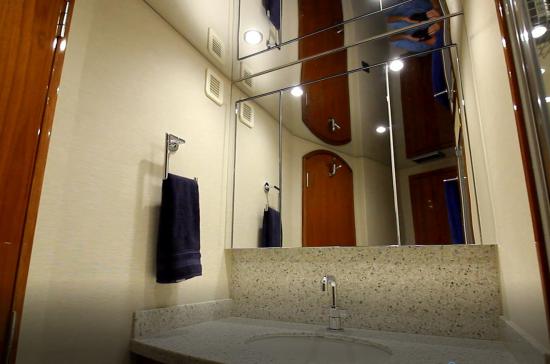

Laundry
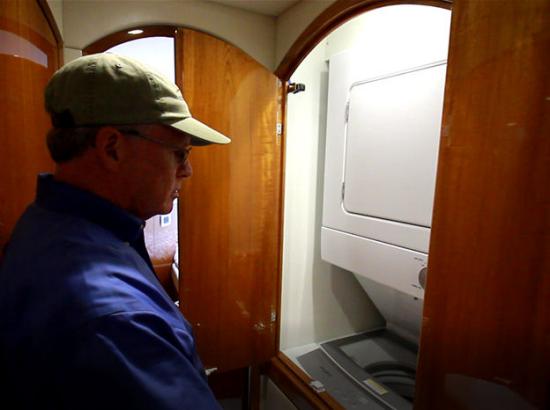

Forward Stateroom
The forward stateroom on our test boat had two bunks in what is known as a 60/40 berth (one is bigger than the other). It is an option to have an island-style berth as in the drawing above.
Our experience is that this arrangement is the best way to go for this type of vessel. It offers more versatility, and the beds are more comfortable than a high, island bed. Also, there is more deck space in this arrangement. When a couple wants to snuggle, they can use the larger bed, then get some peaceful sleep in the separate beds.
If the boat is ordered with the optional third head (replacing rod and reel storage) for the third stateroom that could serve as the day head and the attached forward head could become a private ensuite for the forward stateroom.
Crew Cabin
Traditionally, the forward cabin in a sportfishing convertible was used for the captain and mate. And that certainly can be the case in this version of the GT59. Perhaps a better option would be to make the starboard guest cabin for the crew and add the third head.
In this case, the rod storage can be moved into the closet where the wash/dryer is on our test boat or to other locations.
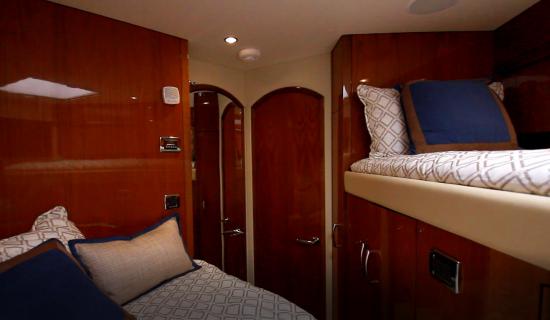
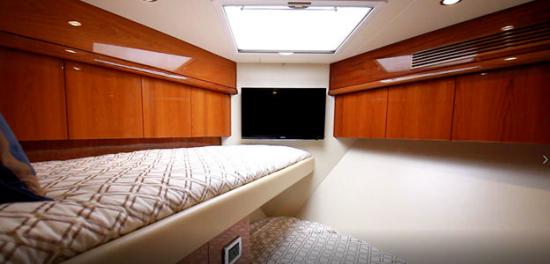
Engine Room
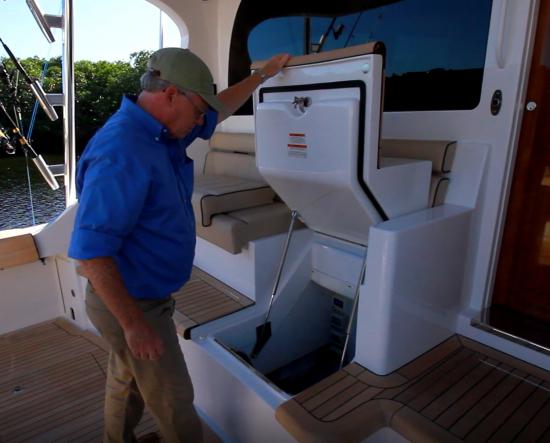
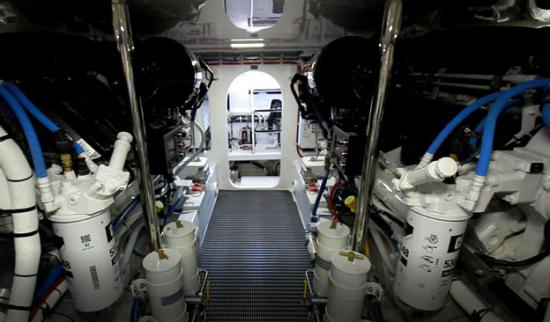
We found it easier to back in and down the three-step ladder because of the 5’2” (1.57 m) headroom between the engines and the high step-over on deck.
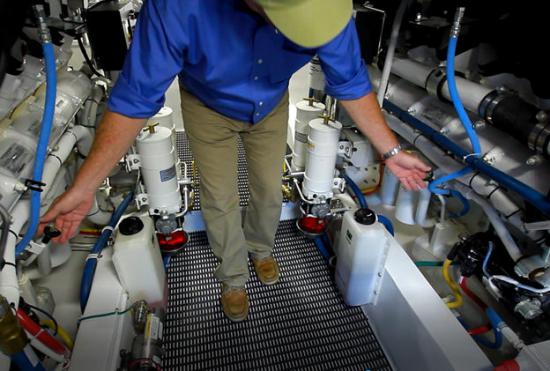
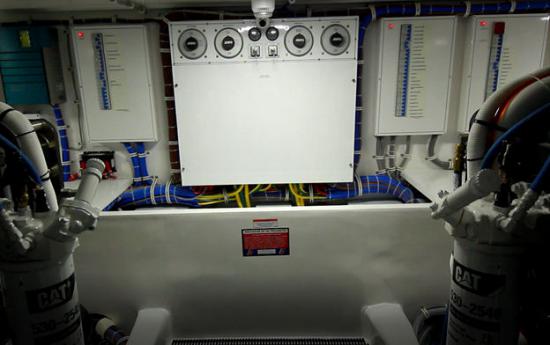

This boat has a Dometic watermaker up forward and to starboard. The fire suppression system is all the way forward next to the water maker. On the port side are the 3 Dometic A/C units, which produce a total of 54,000 BTUs for the vessel.
Two Cummins Onan 21.5 kW diesel generators sit on the aft bulkhead, one behind each engine on our test boat. One generator can supply enough electricity under normal conditions. However, while cruising with the washer/dryer running, the AC, the stove, and a couple of hairdryers, it may be necessary to have both generators running. In any case, the Seakeeper requires the second generator.
Also, it is always advisable to have a backup generator in this type of boat that's so dependent on AC power. We think the twin 21.5 kW generator solution is the perfect one. Like the CAT engines, there are Cummins service shops all over the U.S. and the world because these engines are used so widely in commercial vessels.
Bilge Pumping System
Bilge pumps are important for several reasons in addition to the obvious. Getting water out of the bilge reduces the chances for corrosion, electrical shorts, mildew, and odors. The GT59 bilge has two sumps, something that many boats do not have, but which is the key to keeping a dry bilge. One sump has a 2,000 gph pump, and the other has an 800 gph pump. In addition, there are three 3,700 gph pumps. All bilge pumps have protected heavy-duty float switches.
An emergency auxiliary bilge pump is located in the lazarette which will pump 150 gallons (568 L) a minute – 9,000 gallons (34,069 L) per hour. This is for catastrophic events, and is probably better than having two-way valves on the engine raw water through-hulls, although the engine raw water pumps are not reliant on AC power.
Nevertheless, we find this system one of the best in class.
Options to Consider
- Seakeeper 16 gyro
- A second 21.5 kW generator (especially if the Seakeeper is selected)
- All offshore vessels should have a life raft
- Isinglass for the flying bridge
- A 1200 gpd watermaker
- Tender with cradle on the bow
- Hydraulic davit for tender
- Electric anchor windlass
- Tuna tower
Price
In the $3M range, depending on options.
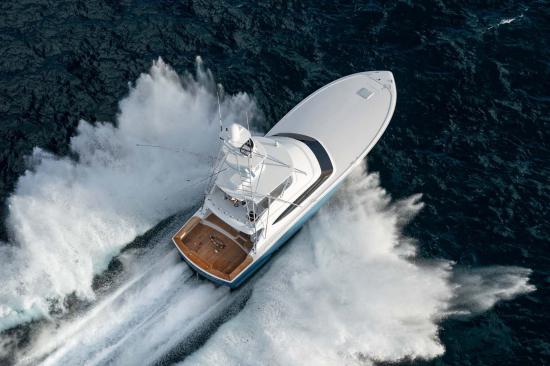
Observations
Hatteras built the first fiberglass fishing/cruising boat in 1960 and she (Nit Wits) is still in service today. The company has a long and proud heritage of building the best boats in class in terms of strength, amenities and systems reliability for most of that time.
Today, under new – and enlightened – private ownership, the company is dedicated to its customers instead of a bean counter in the corporate office. This makes all of the difference in the boat business – both for the buyer and for the longevity of the builder. The reason is that the reputation of the brand is paramount.

